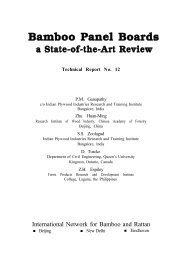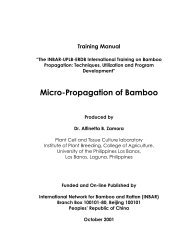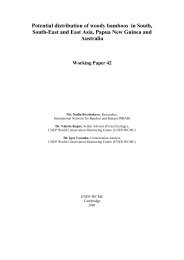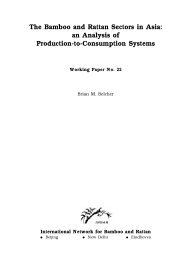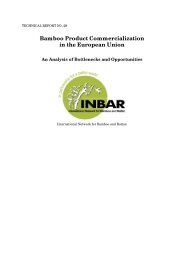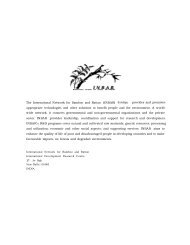ISSN ………… - International Network for Bamboo and Rattan
ISSN ………… - International Network for Bamboo and Rattan
ISSN ………… - International Network for Bamboo and Rattan
You also want an ePaper? Increase the reach of your titles
YUMPU automatically turns print PDFs into web optimized ePapers that Google loves.
The most important industrial refiner mechanical pulping process today is the thermomechanical<br />
pulping (TMP). The process involves an impregnation <strong>and</strong> preheating step of washed wood chips<br />
with saturated steam under pressure. The preheated chips are fed to the disk refiner <strong>for</strong> defibration at<br />
approximately the same temperature <strong>and</strong> pressure as in the preheating stage. The secondary refining<br />
stage is generally carried out at atmospheric pressure. There<strong>for</strong>e, the defibred material is exp<strong>and</strong>ed<br />
into a cyclone where the steam is removed, <strong>and</strong> refined in one or two stages to the desired freeness.<br />
The rejects from screening <strong>and</strong> cleaning are thickened <strong>and</strong> recycled to the refining step or separately<br />
refined. The TMP process yields 91-98 per cent pulp which has a lower brightness than groundwood<br />
pulp.<br />
In the chemimechanical process (CMP), mechanically destructed chips are impregnated with<br />
alkaline peroxide liquor (NaOH/H2O2) at 40-60 0 C at atmospheric pressure <strong>for</strong> 1.5–2 hrs be<strong>for</strong>e lowconsistency<br />
(5%) refining.<br />
Air pollution problems in mechanical pulping are less significant than in chemical pulping. However,<br />
RMP, TMP <strong>and</strong> particularly CRMP <strong>and</strong> CTMP processes cause mill effluents with considerable<br />
amounts of extractives.<br />
The world-wide increase in the application of mechanical, thermomechanical <strong>and</strong> chemimechanical<br />
pulping processes to produce pulps from non-wood fibre sources including bamboo is described<br />
extensively by Misra (1980) 521 .<br />
4.2. Chemical pulping<br />
Chemical pulping employs chemical reagents to effect a separation of the cellulose fibres from other<br />
wood components. Wood chips are cooked with suitable chemicals in aqueous solution, usually at<br />
elevated temperatures <strong>and</strong> pressures. The objective is to dissolve the lignin <strong>and</strong> other extraneous<br />
compounds, leaving the cellulose intact <strong>and</strong> in fibrous <strong>for</strong>m. This objective can be realised to a<br />
commercially satisfactory degree through the use of chemical reagents, although there is an<br />
appreciable dissolution of carbohydrate material <strong>and</strong> degradation of cellulose. Pulp yields are usually<br />
about 50 per cent of the wood weight. Because the chemical processes consume relatively large<br />
quantities of inorganic chemicals such as alkalies, paper makers devised methods <strong>for</strong> reagent chemical<br />
recovery from the spent cooking liquor; recovery has remained an integral part of chemical pulping.<br />
Environmental <strong>and</strong> economical concerns necessitated chemical recovery as a very important part of<br />
chemical pulping.<br />
9



